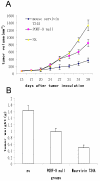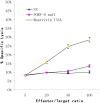Efficient inhibition of murine breast cancer growth and metastasis by gene transferred mouse survivin Thr34-->Ala mutant
- PMID: 18816410
- PMCID: PMC2569909
- DOI: 10.1186/1756-9966-27-46
Efficient inhibition of murine breast cancer growth and metastasis by gene transferred mouse survivin Thr34-->Ala mutant
Abstract
Background: Metastasis in breast cancer is a vital concern in treatment because most women with primary breast cancer have micrometastases to distant sites at diagnosis. As a member of the inhibitor of apoptosis protein (IAP) family, survivin has been proposed as an attractive target for new anticancer interventions. In this study, we investigated the role of the plasmid encoding the phosphorylation-defective mouse survivin threonine 34-->alanine mutant (Msurvivin T34A plasmid) in suppressing both murine primary breast carcinomas and pulmonary metastases.
Methods: In vitro study, induction of apoptosis by Msurvivin T34A plasmid complexed with cationic liposome (DOTAP/Chol) was examined by PI staining fluorescence microscopy and flow cytometric analysis. The anti-tumor and anti-metastases activity of Msurvivin T34A plasmid complexed with cationic liposome (DOTAP/Chol) was evaluated in female BALB/c mice bearing 4T1 s.c. tumors. Mice were treated twice weekly with i.v. administration of Msurvivin T34A plasmid complexed with cationic liposome (DOTAP/Chol), PORF-9 null plasmid complexed with cationic liposome (DOTAP/Chol), 0.9% NaCl solution for 4 weeks. Tumor volume was observed. After sacrificed, tumor net weight was measured and Lung metastatic nodules of each group were counted. Assessment of apoptotic cells by TUNEL assay was conducted in tumor tissue. Microvessel density within tumor tissue was determined by CD31 immunohistochemistry. Alginate-encapsulated tumor cells test was conducted to evaluate the effect on angiogenesis. By experiment of cytotoxicity T lymphocytes, we test whether Msurvivin T34A plasmid complexed with cationic liposome (DOTAP/Chol) can induce specific cell immune response.
Results: Administration of Msurvivin T34A plasmid complexed with cationic liposome (DOTAP/Chol) resulted in significant inhibition in the growth and metastases of 4T1 tumor model. These anti-tumor and anti-metastases responses were associated with triggering the apoptosis of tumor cells directly, inhibiting angiogenesis and inducing specific cellular immune response.
Conclusion: The present findings suggest that the Msurvivin T34A plasmid complexed with cationic liposome may provide an effective approach to inhibit the growth and metastases of a highly metastatic mouse breast cancer model with minimal side effects.
Figures









Similar articles
-
Antitumor effect of mSurvivinThr34→Ala in murine colon carcinoma when administered intravenously.Med Oncol. 2010 Dec;27(4):1156-63. doi: 10.1007/s12032-009-9353-2. Epub 2009 Dec 1. Med Oncol. 2010. PMID: 19949901
-
Therapeutic effects of survivin dominant negative mutant in a mouse model of prostate cancer.J Cancer Res Clin Oncol. 2011 Jan;137(1):19-28. doi: 10.1007/s00432-010-0855-2. Epub 2010 Mar 9. J Cancer Res Clin Oncol. 2011. PMID: 20217127 Free PMC article.
-
Inhibition of human lung adenocarcinoma growth using survivint34a by low-dose systematic administration.J Biosci. 2010 Jun;35(2):209-16. doi: 10.1007/s12038-010-0025-3. J Biosci. 2010. PMID: 20689177
-
Enhanced tumor radiosensitivity by a survivin dominant-negative mutant.Oncol Rep. 2010 Jan;23(1):97-103. Oncol Rep. 2010. PMID: 19956869
-
Co-delivery of doxorubicin and plasmid by a novel FGFR-mediated cationic liposome.Int J Pharm. 2010 Jun 30;393(1-2):119-26. doi: 10.1016/j.ijpharm.2010.04.018. Epub 2010 Apr 21. Int J Pharm. 2010. PMID: 20416367
Cited by
-
Targeting PRPK Function Blocks Colon Cancer Metastasis.Mol Cancer Ther. 2018 May;17(5):1101-1113. doi: 10.1158/1535-7163.MCT-17-0628. Epub 2018 Feb 26. Mol Cancer Ther. 2018. PMID: 29483219 Free PMC article.
-
Gene therapy for C-26 colon cancer using heparin-polyethyleneimine nanoparticle-mediated survivin T34A.Int J Nanomedicine. 2011;6:2419-27. doi: 10.2147/IJN.S23582. Epub 2011 Oct 19. Int J Nanomedicine. 2011. PMID: 22072877 Free PMC article.
-
Tiamulin inhibits breast cancer growth and pulmonary metastasis by decreasing the activity of CD73.BMC Cancer. 2017 Apr 11;17(1):255. doi: 10.1186/s12885-017-3250-4. BMC Cancer. 2017. PMID: 28399915 Free PMC article.
-
Nucleic acid cancer vaccines targeting tumor related angiogenesis. Could mRNA vaccines constitute a game changer?Front Immunol. 2024 Jul 16;15:1433185. doi: 10.3389/fimmu.2024.1433185. eCollection 2024. Front Immunol. 2024. PMID: 39081320 Free PMC article. Review.
-
Survivin-T34A: molecular mechanism and therapeutic potential.Onco Targets Ther. 2010 Dec 6;3:247-54. doi: 10.2147/OTT.S15293. Onco Targets Ther. 2010. PMID: 21289859 Free PMC article.
References
-
- Jemal A, Siegel R, Ward E, Murray T, XU J, Thun MJ. Cancer statistics, 2007. CA Cancer J Clin. 2007;57:43–66. - PubMed
-
- Huang X, Wong MK, Yi H, Watkins S, Laird AD, Wolf SF, Gorelik E. Combined therapy of local and metastatic 4T1 breast tumor in mice using SUan inhibitor of angiogenic receptor tyrosine kinases, and the immunostimulator B7.2-IgG fusion protein. Cancer Res. 6668;62:5727–5735. - PubMed
-
- Pulaski BA, Rosenberg SO. Reduction of established spontaneous mammary carcinoma metastases following immunotherapy with major histocompatibility complex class II and B 7.1 cell-based tumor vaccines. Cancer Res. 1998;58:1486–1493. - PubMed
Publication types
MeSH terms
Substances
Grants and funding
LinkOut - more resources
Full Text Sources
Medical
Research Materials
Miscellaneous

